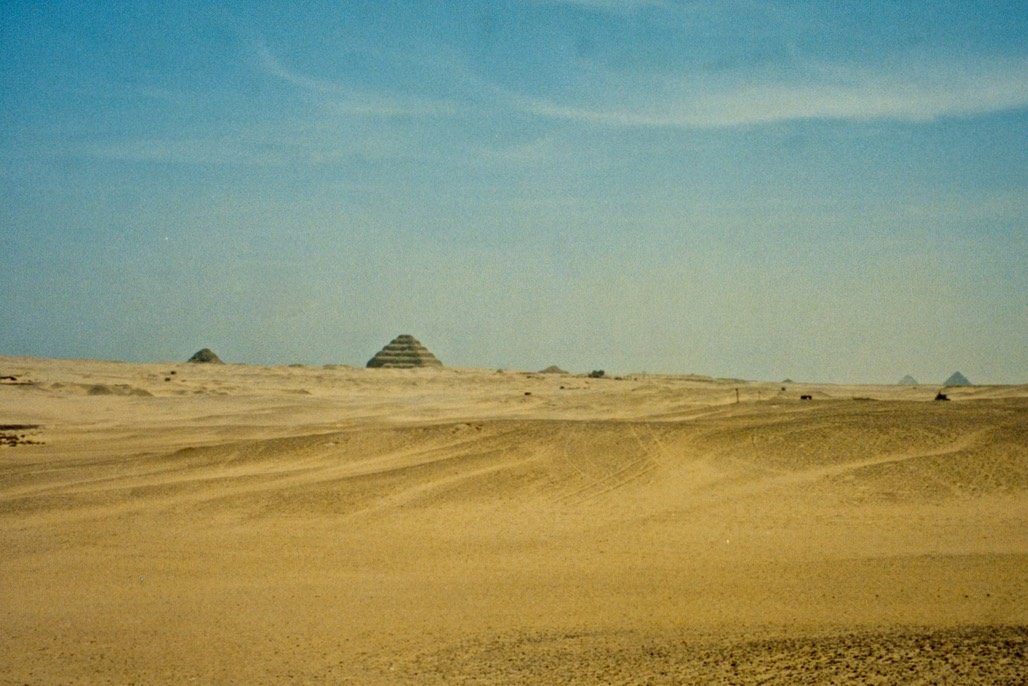First, a theory of my own - that the various necropoles of the Pyramid Age were connected in a very simple way. Each was visible precisely on the horizon from one another. This connected them so effectively that it seems likely that the ancient Egyptians thought of them as one royal necropolis.
Let's briefly examine the photographic evidence:
First, viewing the 4th Dynasty Pyramids of Giza from those of the 5th Dynasty at Abusir, less well known, but nonetheless quite similar in concept and ground plan to the Giza Pyramids. The picture shows that Abusir pyramids have not withstood the ravages of time as well as Giza: nonetheless, their relative positions on mutual horizons is evident.
Next we see the Abusir Pyramids on the horizon, this time observed from Saqqara, close to Memphis where the king's of the period ruled, and where Djoser has his first, Stepped Pyramid: again the siting on the horizon is precise.
Looking in the other direction from Saqqara, we see Snefru's 'Bent" and Red Pyramids at Dashur. Snefru was Khufu's father. Again, the precision with which the two pyramids are set on the horizon is notable and surely significant.
Next in the series is the incomplete pyramid of Djedefre, one of Khufu's sons, at Abu Roash, to the north of Giza. Yet again, the Giza Pyramids can be seen faintly through the haze, but precisely on the horizon.
Zawiyet el-Aryen is a little known site, off the tourist trail. It is on a ridge a mile south of Giza, and it was here that the third Dynasty King Khaba may have created a tomb, now in ruins, but similar in design to that of Djedefre. From here, looking north we see the Great Pyramid on the horizon:

Giza Pyramids (and Rostau?) from Zawiyet el Aryen
Between the two sites is some government enclosure, but the horizon view is unmistakable, at least for the Great Pyramid on the right — none had been built when Zawiyet -el-Aryen was in use. So, you might reasonably ask, would the builders at Zawiyet el-Aryen want to position their pyramid with a horizon view of Giza, when no pyramid had yet been built there?
That, as they say, is the 64M$ question. And the answer seems to be that the Giza plateau had long been revered as Rostau, the entrance to the Duat, or underworld: long before the pyramids, it seems. So, there appear to be two pivots for the various Royal Necropole: The Stepped Pyramid at Saqqara to the South; and the Great Pyramid at Giza to the North, sitting as it did (does?) over the Primeval Mound which may have covered the entrance to the Duat…
Looking in the opposite direction from Zawiyet el-Aryen, we see:

The Abusir pyramids and the Stepped Pyramid, centre right in the distance, from Zawiyet el-Aryen, and…

The Stepped Pyramid again, centre left, and in the furthest distance, at the right,
may be seen the Bent and the Red Pyramids at Dashur - just!
Neolithic tumuli are usually to be found on the horizon, as though their sites were chosen to have a commanding view, but this is something more: there appears to be a determined plan to maintain visibility, necropolis to necropolis, horizon to horizon. So, here we have one of my theories about the 3rd, 4th and 5th Dynasty pyramids - that the various necropoles were carefully chose to form a chain of sites where each was visible from the next by being place precisely on the horizon. Since the various royal necropoles were joined by this horizon view, there was - in effect - only one, extended Royal Necropolis in the 3rd, 4th and 5th Dynasties.
Have I made my case? You be the judge…